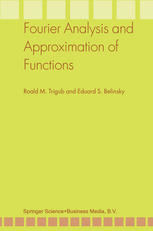

Most ebook files are in PDF format, so you can easily read them using various software such as Foxit Reader or directly on the Google Chrome browser.
Some ebook files are released by publishers in other formats such as .awz, .mobi, .epub, .fb2, etc. You may need to install specific software to read these formats on mobile/PC, such as Calibre.
Please read the tutorial at this link: https://ebookbell.com/faq
We offer FREE conversion to the popular formats you request; however, this may take some time. Therefore, right after payment, please email us, and we will try to provide the service as quickly as possible.
For some exceptional file formats or broken links (if any), please refrain from opening any disputes. Instead, email us first, and we will try to assist within a maximum of 6 hours.
EbookBell Team

5.0
90 reviewsIn Fourier Analysis and Approximation of Functions basics of classical Fourier Analysis are given as well as those of approximation by polynomials, splines and entire functions of exponential type.
In Chapter 1 which has an introductory nature, theorems on convergence, in that or another sense, of integral operators are given. In Chapter 2 basic properties of simple and multiple Fourier series are discussed, while in Chapter 3 those of Fourier integrals are studied.
The first three chapters as well as partially Chapter 4 and classical Wiener, Bochner, Bernstein, Khintchin, and Beurling theorems in Chapter 6 might be interesting and available to all familiar with fundamentals of integration theory and elements of Complex Analysis and Operator Theory. Applied mathematicians interested in harmonic analysis and/or numerical methods based on ideas of Approximation Theory are among them.
In Chapters 6-11 very recent results are sometimes given in certain directions. Many of these results have never appeared as a book or certain consistent part of a book and can be found only in periodics; looking for them in numerous journals might be quite onerous, thus this book may work as a reference source.
The methods used in the book are those of classical analysis, Fourier Analysis in finite-dimensional Euclidean space Diophantine Analysis, and random choice.